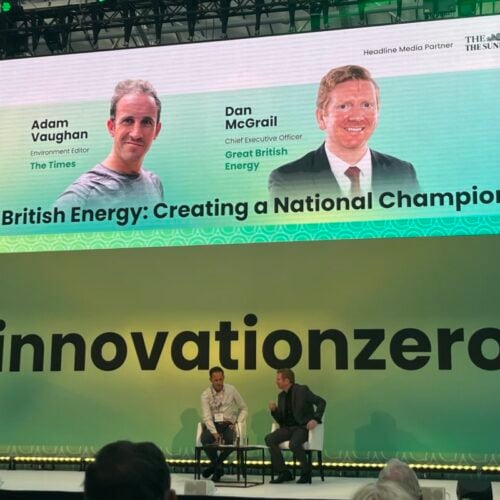As parliament returns from summer recess this week, many expect the Labour government to take the next steps to establish its Great British Energy (GB Energy) company.
On 25 July, UK Prime Minister Keir Starmer introduced the Great British Energy Bill “to make provision about Great British Energy”. As such, the energy company has been formalised in so far as a commitment to commit to a plan has been made.
Since first being named as one of Labour’s ambitions when it stood as opposition to the Conservatives in September 2023, GB Energy has been “at the heart” of Labour’s clean energy plans, promising energy security, lower energy bills and to deliver the UK’s transition to net zero carbon emissions.
Great British Energy will be an operationally independent company owned by the Secretary of State for Energy Security and Net Zero, led by its own CEO and overseen by an independent fiduciary board rather than ministers. Trade unions will be represented within the company.
Ahead of the Great British Energy Bill undergoing a second reading on 5 September, Current± explores what we already know about the company and what the industry hopes to see from it.
What GB Energy will do
There has been some back and forth on what exactly GB Energy’s function will be. At the end of May this year, campaigning for leadership, Keir Starmer said GB Energy would be an “investment vehicle, not an energy company”.
This was in direct conflict with what was then announced, after Labour’s electoral victory, in a briefing that came alongside the King’s Speech: that GB Energy will have a mandate to develop, own and operate clean energy assets.
The publicly-owned company will effectively be an investment platform for the government to funnel money into low carbon energy projects—the returns from which will be felt by consumers.
There is a consensus across the industry that the energy company should keep its focus on investing, not developing.
Deputy policy director and head of power and flexibility at the Association for Renewable Energy and Clean Technology (REA), Mark Sommerfeld, told Current±: “There is a clear position that if GB Energy is to be effective in delivering more renewables and helping the sector as a whole, it needs to be very careful of not crowding out other investors.
“Those higher risk value areas are where we think GB Energy should be focusing attention; those areas which are nascent technologies, where the technology has a potentially higher risk profile and where it’s harder for the private sector to invest.”
GB Energy, backed by government money and having access to low interest rates, will be in a strong position to invest. However, Sommerfeld says there is plenty of private money, but barriers to market can prevent investment.
If the state-owned energy company will invest, develop and own projects, “then it really does need to be those technologies which are critically important to meeting net zero, but where private investment is not already in place”.
Acting director of strategic communications for RenewableUK, Nathan Bennett, says that, for the trade association, the most exciting role GB Energy could play is to help innovative technologies, particularly tidal power generation and floating offshore wind.
According to Bennett, the wind industry expects to see the least additionality from GB Energy in well-established technologies, like fixed base offshore wind, where market maturity and private investment mean GB Energy might be detrimentally disruptive.
He added that its role around onshore renewables, supporting community solar and onshore wind through grant programmes or venture partnerships with developers looking at existing projects, is something the industry is comfortable with and supportive of.
Further, Bennett pointed out that polling has shown having a GB Energy equity stake in a project improves its popularity with the public.
Sommerfeld says he can see a world in which GB Energy invests, develops and then “hands over to the private sector”, which would bring immediate returns for GB Energy and establish those projects at an accelerated pace.
Learning from past mistakes
There is some crossover between what Great British Energy has been described and the function served by the UK Green Investment Bank (GIB).
The investment platform was established by the Department for Business, Energy and Industrial Strategy (BEIS) in 2012 was considered a jewel in the crown of UK low carbon policy until, in a widely criticised move, the company was privatised.
The organisation began with £3.8bn in capital from the government, which reportedly mobilised £10.1 billion of investment that was used to partially fund a wide range of green projects, including a £1.2 billion offshore wind farm off the coast of Brighton.
Australian investor Macquarie acquired the UK Green Investment Bank (GIB) in 2017, forming the Green Investment Group (GIG).
According to Sommerfeld, despite some positives, the GIB focused “very much on established technologies and getting immediate returns”, failing to deliver on the potential held by a publicly funded bank in “actually driving the agenda forward”.
Indeed, clarity around what GB Energy will invest in might be a good next step for the government to show the industry that it is committed to using its money most effectively.
GB Energy’s impact on planning and the energy market
When GB Energy launched, it came with the announcement of a partnership with the Crown Estate, which operates independently and has a £16 billion portfolio of UK land and seabed. According to the Crown Estate, the collaboration will see up to 20-30GW of new offshore wind developments reaching seabed lease stage by 2030.
However, while the partnership will speed up project timelines and potentially simplify seabed allocations, “the planning rules are the planning rules”. Sommerfeld says the hope is that the fact that public money will be spent on those projects, combined with the impetus placed on GB Energy to deliver projects early and soon, will push the government to address planning barriers more comprehensively.
“They are the same barriers that are affecting the private sector as well, and therefore there is an even stronger impetus and signal to resolve things like grid capacity constraints and planning issues.”
Bennett reiterated this, saying: “Having the right market mechanisms, having the right policy and planning framework is really what will be the key driver of the government’s overarching targets. That is a space where GB Energy can have additionality and help out.”
After the discussion surrounding the review of energy market arrangements (REMA) that preceded the election, there is a sense that now is not the time for dramatic change. Bennet says Labour should take forward reforms, but “be cognizant of the fact that we probably need evolutions to our market instead of any revolutionary changes that might hinder us from landing the investment that we need”.
“We really need to be creating as much investor confidence in the UK as we can, in a very competitive international environment for investment.”





